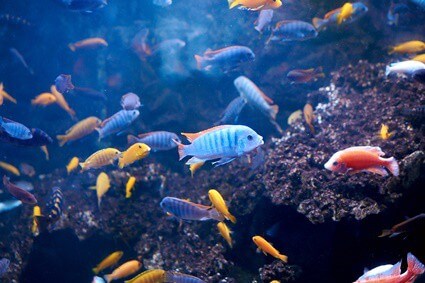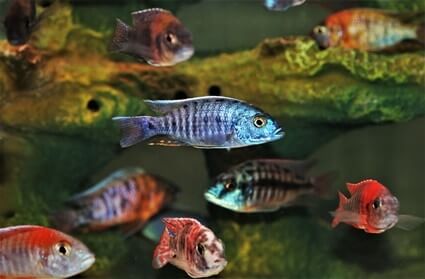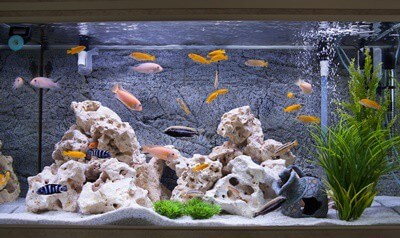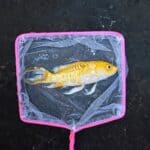Last Updated on: 22nd October 2023, 03:16 pm
Cichlids are among the most aggressive freshwater fish, so owners must be cautious when housing them inside an aquarium, especially if other fish species are present.
Cichlids chase each other because they’re naturally aggressive. Cichlids will also chase other fish when protecting their territory, competing for food, and exerting dominance.
Male cichlids chase females when it’s time to breed and protect their mates.
You can prevent aggression in cichlids by providing a wide tank with ample floor space and rearranging the tank occasionally to reset territorial boundaries.
Cichlids can become stressed and withdrawn if left to chase each other. Similarly, cichlids bite and cause injuries once they’ve caught the fish they were chasing.
Is It Normal for Cichlids To Chase Each Other?
Cichlids are freshwater fish native to tropical America, mainland Africa, Madagascar, and South Asia. They’re from the family Cichlidae in the order Cichliformes.
The most common cichlid species include:
- Angelfish.
- Oscars.
- Discus.
- Firemouth.
- Jack Dempsey.
- African cichlids.
Cichlids are often observed chasing each other around the tank. When this happens, it’s easy to assume that the two fish aren’t getting along.
Sometimes, it’s harmless, and sometimes it indicates a territorial issue within the aquarium.
Cichlid fish pursue each other for the following reasons:
Protecting Territory
Territorial cichlids are most likely to chase other fish inside the tank. Tanks that are too small are the most common cause, as is a lack of hiding spots.
Many cichlids enjoy digging and prefer to occupy the bottom of the tank.
They create caves that they claim as their own. Too-tall tanks don’t allow enough space for cichlids to claim territory, so they fight each other for space and hiding spots.
According to Nature Communications, competition initiates divergence in habitat between cichlid fish.
Chasing caused by territory issues is an act of aggression, and fighting usually occurs afterward.
The signs of fighting include:
- Torn fins and tails.
- Eye injuries.
- Inability to swim well.
- The bullied fish isolates itself.
To prevent this type of aggression, provide a tank that offers plenty of floor space, and opt for a wide tank instead of a tall one so that all cichlids have a specific spot they can call their own.
Also, add rocks and plants to the tank, allowing bullied fish to find small spaces to hide in when chased.

Mating Behavior
Cichlids are aggressive during the breeding seasons when attempting to find a mate.
Dominant male cichlids chase other male fish, who they see as their competition. They also pursue potential female mates to get their attention.
When mating, dominant male cichlids become more aggressive towards other male fish in the tank. A tell-tale sign that male fish are ready to mate is that their scales become dull and pale.
The male fish chase female cichlids aggressively. They also protect them by chasing other fish away, puffing their bodies up. This makes them look bigger and scarier than they are.
Science Daily describes how subordinate male fish wag their tails and quiver their bodies before mating.
Therefore, if you notice the cichlids inside the tank perform this ritual after chasing another fish around the tank, they’re most likely trying to mate.
Similarly, mating fish will move rocks and substrate around at the bottom of the aquarium to create a hole for female fish to deposit their eggs into. These signs signify that eggs are soon to appear at the bottom of the tank.
If male cichlids chase females and try to hurt them, the female fish have strayed into the male fish’s territory but aren’t willing to breed. Male fish will chase them away to defend their territory.
Food Competition
Cichlids chase each other if there isn’t enough food within the tank. They might not attack each other, but the fish are attempting to get the last food traces that usually lie on the bottom of the tank.
Hunger also causes cichlids to become aggressive and encourages them to guard their territory.
Cichlids should be fed 2-3 times a day. When feeding, provide enough food for them for 30 seconds to one minute non-stop.
You might need to increase or decrease this depending on the fish’s weight and hunger levels, but experts agree this is a suitable amount of food to feed cichlids.
If your cichlids still chase each other after receiving enough food, they’re probably defending their territory or attempting to mate.
Dominance
Some species of cichlid, particularly African cichlids, are naturally aggressive. Fish display a range of complex social behaviors, and many cichlids like to dominate the tank.
Weaker, more peaceful fish are usually the first to be chased and attacked, as dominant fish assert their place at the top of the pecking order.
A study in Biology Open found that male African cichlid fish are either subordinate or aggressive. Researchers created a pair of subordinate and aggressive fish.
In every case, there was a male-male confrontation between the resident dominant fish and the intruder, with the latter quickly taking the subordinate role.
However, another study by the University of North Carolina found that low-ranking cichlids can quickly become the dominant fish if their competition isn’t around.
As a result, cichlids are opportunistic creatures that take every opportunity to reign dominance over the tank, chasing each other and fighting to win the crown.
When new dominant fish are created, mating within the tank increases as the male fish pay more attention to females.
This is another reason fish owners see increased chasing within the tank, as males attempt to create a brand-new match with females already in the tank.
What Are The Most Aggressive Cichlids?
Some cichlid fish are more aggressive than other freshwater fish.
As a result, keeping them alongside smaller fish can encourage territorial cichlids to chase and eat them. Be careful of the following cichlid species when keeping them in a tank as pets:
Jack Dempsey Fish
Jack Dempsey fish are one of the most well-known cichlids and are also one of the most aggressive. They don’t mix well with other fish and often harass their tank mates.
A study by Scholar Works looked into the aggressiveness of Jack Dempsey fish. They found that they become more aggressive when placed in environments with minimal hiding places.
Chases were frequent between the fish studied, as were bites when one fish made contact with the other.
Jack Dempsey fish retail for around $5 to $10. Because they’re so cheap, fish enthusiasts pack their tanks with them, not realizing that they grow to be quite large.
As a result, the tank becomes overcrowded and causes the fish to become overly aggressive.
Oscar Fish
Oscar fish are another cichlid species that are known to be aggressive. Oscar fish lock lips with other fish and pursue each other to gain dominance. Oscar fish fight to:
- Assert their position in the pecking order.
- Compete for food.
- Display stress due to the tank’s poor conditions.
Oscar fish become large. Therefore, they need a large tank to accommodate their size, or they start bullying other fish within the aquarium.
Oscar fish also need an ideal environment to keep them happy. This involves a clean tank with no traces of ammonia or nitrites that can make your fish unwell. There also needs to be an ample supply of oxygen.
Rearranging the tank can also help to reduce aggression levels. Providing new hiding places for the fish to explore can distract them from chasing other fish in the tank.
Also, carefully place smaller fish in the tank with Oscar fish. If they’re small enough, Oscars will chase and eat them.
Flowerhorn Fish
Flowerhorn fish are territorial, which makes them aggressive. They have a healthy appetite and must be well-fed to prevent them from chasing other fish. Flowerhorn fish even attack owners while feeding.
Male flowerhorn fish are more aggressive than females. They chase and kill fish within the same tank, especially if they’re significantly smaller.
Some flowerhorns even catch and kill their young not long after they’ve hatched. This is more common when the fish are hungry.
Similarly, male flowerhorns shouldn’t be kept together in the same tank. Male and female fish fare better together, particularly during the breeding seasons.
African Cichlids
African cichlids are another territorial species of fish. They’re rock-dwelling, and all rock-dwelling fish are territorial because they like having parts of the tank to claim.
Captive African cichlids need rocks and other accessories at the bottom of the tank to dig around in.
African cichlids are also aggressive when it comes to mating time. They’ll relentlessly chase female cichlids in the hopes of procreating with them.
To eliminate African cichlid aggression, you must choose a cage that allows the fish space to grow. Keep fish of the same size and temperament within the cage.
How To Prevent Cichlid Aggression
To prevent cichlids from chasing each other, you must remove the factors causing the fish to be aggressive.
Sometimes, like when cichlids are mating, you must let the fish carry out the natural behavior. But when chasing is accompanied by biting and injury, fish owners need to step in.
You can prevent cichlid aggression by following these steps:
Avoid Small Fish
To stop your cichlids from chasing weaker fish, it’s best to choose tank mates that are similar in size. This keeps the territory levels within the tank at a level playing field.
It’s wise to choose fish that have a similar temperament to cichlids.
Even more aggressive fish will bring out the worst of cichlids, while more docile fish risk being bullied, chased, and harmed.
Finding fish that prefer to occupy other tank areas is also a good idea. This will prevent your fish from fighting for territory at the bottom of the tank.
Research suitable fish species before deciding and seek expert advice from a reputable fish retailer.
Fish with Different Colors
African cichlids see their species as competitors and become more territorial towards them.
They distinguish fish by their colors and patterns. African cichlids will act unfavorably toward the fish, chasing and fighting them if they look similar to their colors.
As a result, choosing fish for your tank that look different in coloration and patterning should help stop this kind of aggression.
You can find cichlid fish in various colors, so it shouldn’t be too hard to fight suitable fish for cichlids to live harmoniously amongst.

Optimal Tank Setup
When choosing a tank, ensure it has adequate floor space. Cichlids flock to the bottom of the aquarium, where they can burrow and hide amongst the rocks.
Without enough floor space, cichlids will begin to chase each other and fight for territory within the tank. This causes some of the smaller subordinate fish to become stressed and unwell.
Similarly, include rocky areas within the aquarium. This is proven to reduce aggression while providing cover for fish that are being harassed.
Rearrange The Aquarium
When introducing new cichlids to your tank, rearrange the rocks and plants within the aquarium to reset the boundaries.
Territorial fish will have to find new areas to claim, giving the more subordinate fish within the tank a chance to claim their territory.
It also lets the newly added fish settle into the tank without being singled out.
Even if you’re not adding new fish, rearranging the tank every other month is an excellent way to prevent territories from forming and dominant fish from taking control.
It should also help to alleviate fish chasing each other within the tank.
How To Stop A Cichlid Bullying?
Some cichlid species are notorious for singling smaller fish out and bullying them to gain dominance inside the aquarium.
While overcrowding is one of the leading causes of aggression within tanks, it can help curb cichlids chasing one another.
This is because packing the tank with a few more fish makes it difficult for cichlids to focus on one particular fish, preventing smaller, vulnerable fish from becoming singled out and bullied.
Beware of overcrowding the tank too much. If too many fish are crowded into a small space, they’ll become stressed.
Therefore, don’t pack the tank with too many fish – add a few more than the gallon rule allows, which states that there should be 1 inch of fish per gallon of water.
It’s not always a bad sign when cichlids chase each other. However, it can signify that they’re trying to assert dominance over other fish inside the tank.
This can cause stress and injury if the cichlid manages to catch and bite the other fish. If you can’t resolve the problem, you may have to separate aggressive cichlids from the other fish.







